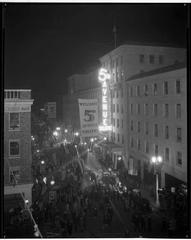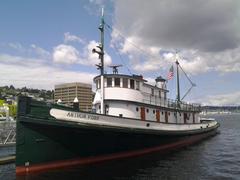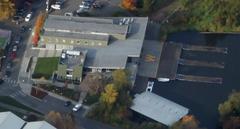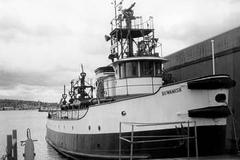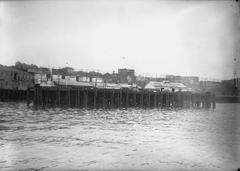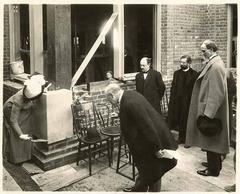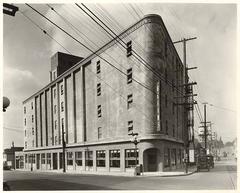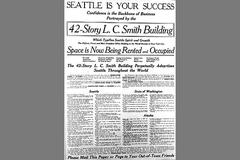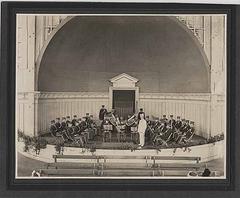
Discovery Park Seattle: Visiting Hours, Tickets, and Attractions Guide
Date: 04/07/2025
Introduction
Discovery Park, Seattle’s largest urban green space, spans 534 acres in the Magnolia neighborhood. As a vibrant blend of natural beauty, layered history, and cultural significance, the park invites visitors to immerse themselves in forests, meadows, tidal beaches, and historic sites. From the iconic West Point Lighthouse to the Daybreak Star Indian Cultural Center, Discovery Park tells the story of Seattle’s Indigenous heritage, military legacy, and community-driven preservation (Seattle.gov, Seattle Parks).
This comprehensive guide details everything you need to know about Discovery Park: visiting hours, ticketing and accessibility, major attractions, historical context, travel tips, and frequently asked questions. Whether you’re seeking a peaceful retreat, an educational outing, or a window into Seattle’s past, Discovery Park delivers an unparalleled urban wilderness experience (allseattle.net, Seattle Met).
Table of Contents
- Introduction
- Indigenous Heritage and Early History
- Fort Lawton: Military Era and Transformation
- Activism and the Daybreak Star Indian Cultural Center
- Park Planning and Preservation
- Visitor Information: Hours, Tickets, and Accessibility
- Trails, Landmarks, and Activities
- Seasonal Highlights and Travel Tips
- Frequently Asked Questions (FAQ)
- Conclusion and Planning Resources
- References
Indigenous Heritage and Early History
Discovery Park sits on ancestral Coast Salish land, home to the Duwamish, Suquamish, Tulalip, and Muckleshoot nations for at least 4,000 years, possibly longer. Known as PKa’dz Eltue (“thrust far out”), the West Point peninsula was a vital gathering and trading place for these communities (Seattle.gov). The land’s significance endures through ongoing partnerships with Native organizations and the presence of the Daybreak Star Indian Cultural Center, ensuring that Indigenous history and stewardship remain central to Discovery Park’s identity (Seattle.gov).
Fort Lawton: Military Era and Transformation
In 1898, the U.S. government established Fort Lawton on Magnolia Bluff, recognizing its strategic value in defending Puget Sound (Seattle City Archives). The fort served as a training and embarkation site during major conflicts, including World Wars I and II and the Korean War, and left a legacy of military structures and stories—such as the WWII Italian POW incident and a historic court-martial (Daily UW).
By the late 1960s, the military’s need for the site waned, and the land was declared surplus. Seattle’s citizens, through advocacy and the federal “Legacy of Parks” program, pressed for its conversion to public space (Seattle City Archives).
Activism and the Daybreak Star Indian Cultural Center
Indigenous activism played a pivotal role in Discovery Park’s story. In 1970, Bernie Whitebear and the United Indians of All Tribes Foundation led a peaceful occupation of Fort Lawton, demanding land for a cultural center (Seattle Met). Their efforts led to the establishment of the Daybreak Star Indian Cultural Center in 1977—a continuing hub for education, art, and cultural events (United Indians of All Tribes Foundation).
Park Planning and Preservation
The park’s development was guided by the 1972 Dan Kiley master plan, which prioritized open space, ecological restoration, and passive recreation over intensive development (Friends of Discovery Park). Competing visions—ranging from golf courses to housing—were ultimately set aside in favor of preserving tranquility and natural habitats, a principle that shapes the park’s management to this day (Seattle City Archives).
Visitor Information: Hours, Tickets, and Accessibility
- Visiting Hours: Daily, 4:00 AM to 11:30 PM (Seattle Parks)
- Admission: Free; no tickets required for general access
- Parking: Free lots near the Visitor Center, Daybreak Star Center, and West Point Lighthouse trailhead; lots fill quickly on weekends
- Accessibility: Wheelchair-accessible trails (Loop Trail segment, Visitor Center), accessible restrooms, and parking
- Public Transit: King County Metro buses serve the area (travellemming.com)
- Dog Policy: Dogs allowed on leash (prohibited on the Wolf Tree Nature Trail and certain sensitive areas)
- Restrooms & Picnic Areas: Available near the Visitor Center and select trailheads
Trails, Landmarks, and Activities
Trail System
Discovery Park offers 11+ miles of trails through forests, meadows, bluffs, and beaches (allseattle.net). The 2.8-mile Loop Trail provides a comprehensive overview of the park’s ecosystems and is accessible for most visitors. Other notable trails:
- South Beach Trail: Leads to West Point Lighthouse and Puget Sound beaches
- North Beach Trail: Forested route to quieter beach areas
- Wolf Tree Nature Trail: A half-mile loop renowned for native plants and wildlife (no dogs/jogging)
- Hidden Valley Trail: A more secluded, moderately steep trail with stream crossings
Iconic Landmarks
- West Point Lighthouse: Built in 1881, still operational, and a favorite spot for photography and sunset views (Triphobo)
- Daybreak Star Indian Cultural Center: Hosts art exhibits, cultural events, and annual powwows
- Historic Fort Lawton District: Parade grounds, Officer’s Row, chapel, and barracks with interpretive panels
Activities
- Birdwatching: Over 270 bird species recorded, especially active during spring and fall migrations
- Wildlife Viewing: Black-tailed deer, raccoons, river otters, and occasional marine mammals
- Environmental Education: Programs and guided walks offered by the Environmental Learning & Visitor Center (check for current availability)
- Picnicking: Grassy lawns and scenic viewpoints throughout the park
Seasonal Highlights and Travel Tips
- Spring: Wildflowers, returning migratory birds, active amphibians
- Summer: Lush greenery, best for hiking, and the Seafair Indian Days Powwow in July
- Autumn: Colorful foliage, salmon runs in streams
- Winter: Quieter trails, panoramic views, and storm-watching opportunities
Tips:
- Dress in layers and bring rain gear year-round
- Visit early or late in the day to avoid crowds
- Carry water, snacks, and binoculars for wildlife viewing
- Stay on marked trails to protect sensitive habitats
Frequently Asked Questions (FAQ)
What are the opening hours?
Discovery Park is open daily from 4:00 AM to 11:30 PM.
Is there an entrance fee or tickets required?
No, admission is free and open to the public.
Are pets allowed?
Dogs are allowed on leash except on the Wolf Tree Nature Trail and certain protected areas.
Is the park wheelchair accessible?
Yes, many trails and facilities (notably the Loop Trail and Visitor Center) are accessible to visitors with mobility challenges.
Are guided tours available?
Occasional guided walks and cultural tours are offered through the Environmental Learning & Visitor Center and Daybreak Star Center—check their websites for details.
Where can I park?
Parking lots are available near the Visitor Center, Daybreak Star Center, and West Point Lighthouse trailhead. Early arrival is recommended during peak times.
Conclusion and Planning Resources
Discovery Park is more than a park—it’s a living legacy of Indigenous stewardship, military history, and Seattle’s commitment to preserving open space and cultural heritage. With free admission, accessible amenities, diverse landscapes, and a wealth of learning opportunities, it stands as a model for urban parks nationwide (Seattle City Archives, Friends of Discovery Park, Seattle Met).
Plan your visit:
- Download the Audiala app for guided audio tours, trail maps, and real-time updates
- Visit the Seattle Parks & Recreation Discovery Park page for maps, event calendars, and accessibility info
- Explore the Friends of Discovery Park and United Indians of All Tribes Foundation for educational resources and event listings
Enhance your experience:
- Attend special events, join a guided tour, or explore nearby attractions like the Ballard Locks and Museum of History & Industry
- Respect the park’s natural and cultural heritage by staying on trails and observing Leave No Trace principles
Discover more:
Check out our related articles on Seattle’s top parks and historical sites, and follow us on social media for the latest Discovery Park updates.
References
- Seattle.gov, Indigenous Heritage and Park Information
- Seattle City Archives, Discovery Park History
- Daily UW, Military History of Fort Lawton
- Seattle Parks, Visitor Information
- Friends of Discovery Park, History and Conservation
- Seattle Met, Fort Lawton and Native Activism
- The Cultural Landscape Foundation, Olmsted Brothers and Park Design
- Vacation Washington State, Discovery Park Overview
- Triphobo, West Point Lighthouse Information
- United Indians of All Tribes Foundation, Daybreak Star Cultural Center
- Seattle Parks & Recreation Discovery Park Page
- All Seattle, Natural and Recreational Highlights
- Travellemming, Seattle Travel Tips
- Seeking the Now, Local Guide to Seattle
- PlanetWare, Seattle Attractions
- Jess Watts, A Local’s Guide to Visiting Seattle

